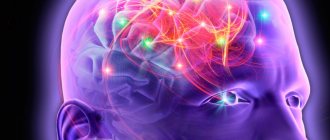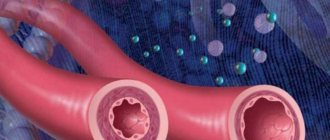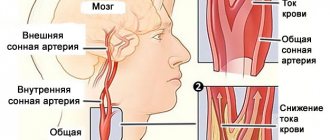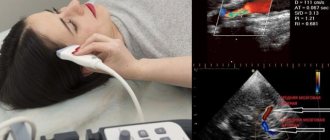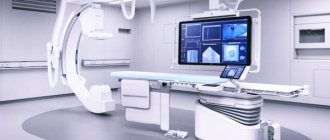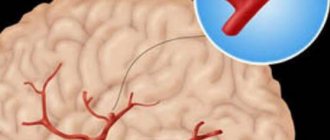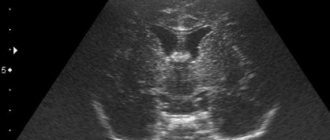Much depends on the functioning of the brain, namely the quality and duration of a person’s life. This organ is designed in such a way that the slightest delay in the supply of nutrients and oxygen to it is fraught with negative consequences, including the death of some nerve cells and tissue necrosis.
All substances necessary for the functioning of the central nervous system are supplied through an extensive network of blood vessels. With their help, through the blood, trace elements enter the nervous tissue, and the metabolic products of its cells are also removed. Therefore, any pathologies of the circulatory system of the brain are sure to affect a person’s condition and behavior.
In order to understand how the blood vessels of the brain affect the functioning of the organ, what it even is, you should delve a little deeper into the study of the functioning of the structures of the central nervous system.
Brain vessels: blood supply system
Vascular lesions of the brain and spinal cord are the most important problem in clinical neurology
.
The blood supply to the brain is characterized by the presence of an optimal regime that ensures continuous and timely replenishment of its energy and other costs during life.
The main function of the nervous system is to regulate the physiological processes of the body, adapting to constantly changing environmental conditions.
The nervous system adapts the body to the external environment, regulates all internal processes and their constancy - constancy of body temperature, biochemical reactions, blood pressure, tissue nutrition processes and providing them with oxygen, etc.
That is why the importance of the intensity of nutrition of the nervous tissue and its sufficient enrichment with blood is very great. At rest, approximately 750 ml of blood per minute passes through the human brain. This corresponds to 15% of cardiac output.
Normal nutrition of all parts of the brain and the hemispheres themselves is ensured due to the structural organization and physiological mechanisms of regulation of brain vessels.
In the gray matter, the blood circulation of the brain is more intense than in the white matter. Compared to adults, in children under 1 year of age it is the most saturated - the nutritional intensity is 50-55% higher.
And in elderly , the intensity of blood supply is reduced by 20% or more. In this case, about one fifth of the total blood volume is pumped by the vessels of the brain.
The nervous system remains constantly active, even during sleep. At the time of dreaming (the REM sleep phase), the level of metabolism in many brain structures can be even greater than in the waking state. All this determines the extremely high need of the brain for oxygen.
With a mass of approximately 1400 g, representing about 2.% of body weight, it absorbs 20% of all oxygen and 17% of all glucose entering the human body.
Thrombosis
The clinical picture of vascular thrombosis corresponds to that of ischemic stroke. It usually begins during sleep or after it, the main cause is atherosclerosis (often in combination with hypertension). The detachment of a blood clot causes a narrowing of the blood vessels in the brain, up to its complete blockage - occlusion.
Symptoms increase, often over several days, manifesting themselves as paresis on the side of the opposite limbs, impaired motor activity of the lower jaw, and visual function.
Constriction of blood vessels in the brain
In other cases, narrowing of blood vessels in the circulatory system is called pathological stenosis of cerebral vessels, which quite often occurs due to the development of atherosclerosis in the cavity of the coronary arteries.
Due to the large amount of accumulated plaque, this leads to the closure of the arteries and obstruction of blood flow to the nerve tissue.
Atherosclerotic plaques in the head usually form in the final stages. The development of the disease can be traced over decades.
In some cases, after a long, gradual and unnoticeable development, a sudden proliferation of lipid tissues, deformation of veins and a sharp deterioration in health occur. The appearance of plaques in the brain and damage to the arteries may be a consequence of the sudden abrupt development of the disease.
The danger of their formation and growth is due to the fact that they can break away from the walls of blood vessels and move through the circulatory system, and once they get into a small vessel, completely clog it.
Signs of cerebral vasoconstriction
The amount of blood required for the organ to function properly is reduced; disturbances lead to tissue ischemia (oxygen starvation), changes in the structure of cells, and subsequently to their mass death (the appearance of foci of necrosis).
Changed or dead nerve cells of the brain are not able to perform their functions (conducting a bioelectric impulse), therefore vasoconstriction is manifested by numerous neurological symptoms:
- headaches;
- dizziness;
- insomnia.
The pathology develops slowly and is almost asymptomatic in the initial stages. If the cause of stenosis is eliminated at this moment, the disease can be cured, completely restoring brain function (92%).
The chronic form of stenosis can plague a person for years, and the initial form can lead to death at the very first stage, which is why it is so important not to miss the “signals” about the disease.
Possible signs of vasoconstriction:
- Migraine , irritability, fatigue, touchiness, tearfulness, overexcitement. functional disorders of the central nervous system;
- Memory problems Short-term forgetfulness, inability to remember what happened a few minutes ago;
- Development of dementia With dementia, cognitive processes deteriorate, and there is a depletion of emotional reactions and character traits;
- Change in gait ( person shuffles or minces heavily);
- Loss of coordination of movements, loss of balance;
- Malfunctions in the functioning of internal organs located in the pelvic area;
- Temporary loss of vision ;
- Vomiting , paresis, paralysis;
- The appearance of a false urge to urinate ;
Symptoms
Photo: zhang-zhung.ru
Symptoms of cerebral aneurysm
Doctors identify the following symptoms of cerebral aneurysm:
- Attacks of nausea;
- Vomit;
- A sharp deterioration in vision;
- Photophobia;
- Double vision;
- Numbness of body parts, mainly on one side;
- Headache;
- Hearing problems;
- Speech impairment.
Doctors strongly recommend that if at least one of these symptoms appears, you should immediately go to the hospital, because the sooner an aneurysm is detected, the easier it will be to cure.
Headache with cerebral aneurysm is most often paroxysmal, similar to migraine. The pain is localized in different places, but most of all it manifests itself in the back of the head. One of the signs is considered to be a pulsating noise in the head area. As the blood flow accelerates, the noise increases.
Signs of a cerebral aneurysm that are not considered major, but which should still be paid attention to:
- Strabismus;
- Sharp noises in the ears;
- Strong dilation of the pupils;
- Drooping of the upper eyelid;
- Hearing loss on one side;
- Vision problems such as distortion of objects, cloudy vision;
- Sudden onset of weakness in the legs.
When an aneurysm ruptures, there is unbearable sharp pain.
Very often, aneurysm occurs in children, mainly in boys under two years of age. It is located in the postcranial fossa and is quite large in size. Symptoms are similar to those in adults.
The main reasons why a cerebral aneurysm may occur are:
- Traumatic brain injury;
- Head wound;
- High blood pressure;
- Various types of infections;
- Atherosclerosis (problems with blood vessels, which are accompanied by the fact that cholesterol begins to be deposited on the walls of blood vessels);
- Other diseases that have a detrimental effect on blood vessels;
- Drugs and cigarettes.
What to do if you discover one of the symptoms of a cerebral aneurysm
If you discover one of the symptoms of a cerebral aneurysm, you should consult a doctor who will prescribe a list of tests and conduct a series of examinations to diagnose the disease and prescribe effective treatment.
Diagnosing an aneurysm is a rather complicated process, since the formation does not manifest itself in any way before the rupture. Diagnosis is carried out using x-ray studies of blood vessels. Studies reveal destruction or narrowing of blood vessels in the brain and parts of the head. Diagnosis is also carried out using computed tomography of the head and magnetic resonance imaging (MRI). An MRI provides the clearest view of the blood vessels and shows the size and shape of the aneurysm.
Initial manifestations of insufficient blood supply to the brain
The diagnosis of “Initial manifestations of insufficiency of blood supply to the brain” often presents great difficulties and cannot always be made with certainty.
However, highlighting this point is important, as it draws attention to this earliest form of vascular brain damage, when preventive and therapeutic measures are most effective.
The diagnosis of initial manifestations of vascular pathology of the brain is made based mainly on the following subjective complaints of the patient:
- headache;
- dizziness;
- noise in the head;
- memory impairment;
- decreased performance.
The basis for diagnosis is only a combination of two or more of these signs that exist for a long time and are constantly or frequently repeated.
They are characterized by their occurrence under circumstances that require increased blood supply to the brain, for example, during intense mental activity, especially if it occurs under hypoxic conditions (in a stuffy, smoky room) or against the background of great fatigue.
In most cases, the cause is atherosclerosis or hypertension.
But the same symptoms can also be caused by other reasons - chronic infections, malignant neoplasms, etc.
The assumption of the vascular origin of the described disorders is supported by rheoencephalography data, as well as the presence of signs of atherosclerotic vascular lesions in other areas (fundus vessels, coronary sclerosis, intermittent claudication, etc.) or symptoms of hypertension (rises in blood pressure, hypertensive retinopathy, left ventricular hypertrophy of the heart) and etc.).
Conditions of working capacity due to cerebral circulatory disorders
| Name | State |
| Cerebral atherosclerosis with initial manifestations of insufficiency of blood supply to the brain without organic symptoms | able to work |
| Atherosclerosis | Temporarily disabled |
| Arterial hypertension | Temporarily disabled |
| Osteochondrosis of the cervical spine | Temporarily disabled |
| Transient disturbance of cerebral circulation in the vertebral-basilar circulation | Temporarily disabled |
| Atherosclerotic stenosis of the right internal carotid artery (lumen narrowing about 75%) | Disabled |
| Infarction in the territory of the right middle cerebral artery | Disabled |
| Left-sided hemiplegia, hemianesthesia, anosognosia | Disabled |
| Hypertension SB degree | Unable to work. Needs outside care and supervision |
| Right-sided hemiparesis and motor aphasia after hemorrhage in the left hemisphere of the brain | Needs outside care and supervision |
| Dementia | Needs outside care and supervision |
| Residual effects after infarction of the anterolateral wall of the left ventricle of the heart | Needs outside care and supervision |
Classification of cerebrovascular diseases
Changes in the structure of the listed elements lead to cerebral circulation disorders of an acute, transient or chronic nature. According to ICD-10, most diseases are in the block labeled I60 to I69. These include:
- hemorrhagic, ischemic, unspecified strokes;
- constriction of cerebral vessels, occlusion;
- aneurysms;
- malformation;
- arteritis;
- sinus thrombosis;
- Moyamoya disease;
- atherosclerotic encephalopathy.
Codes G45 and G46 encode transient (transitory) disorders - narrowing of cerebral vessels, ischemic attack, global amnesia. The classification adopted in Russia is somewhat different, since hypertensive cerebral crisis also belongs to the transient category. And all chronic, slowly progressing disorders are united under the concept of “dyscirculatory encephalopathy.” In addition to those listed, there are several other diseases with unstable symptoms, but the most common ones will be discussed below.
Causes of vasoconstriction
Cerebral vasospasm
Under normal conditions, functional constriction of cerebral vessels occurs constantly, just like their expansion, which is an important mechanism for regulating cerebral circulation.
A danger to health and life is pathological vasoconstriction - arterial spasm. A short-term spasm of the arteries of the brain occurs, for example, in response to mechanical irritation.
Prolonged, persistent spasm is a pathological reaction of the arteries to the action of breakdown products of blood and brain matter.
Among the cerebral circulatory disorders associated with changes in blood properties are an increase in blood viscosity, adhesion of platelets and other formed elements.
Platelet adhesion
Aggregation, or sticking together, of platelets can occur in various pathological conditions of the body (acute renal failure, trauma, etc.).
The small emboli formed in this case, entering the brain vessels, disrupt blood flow and lead to the development of hypoxia and foci of necrosis in the brain substance.
Embolus is any unbound intravascular substrate (solid, liquid or gaseous) circulating through the bloodstream, not found there under normal conditions, capable of causing blockage of an arterial vessel at a sufficiently large distance from the site of occurrence.
Hypertensive diseases
Vascular crises in hypertensive diseases are manifested by spasm and paralysis of intracerebral arteries and arterioles. Both of these processes can take place within the same vascular region of the brain.
Vascular hypertensive crises
play a major role in the occurrence of cerebral hemorrhage.
At the same time, permeability increases, processes of tissue necrosis develop, amylar aneurysms (protrusion of vessel walls up to 3 mm) and ruptures of the walls of intracerebral arteries are formed.
In mild cases, this manifests itself in increased vascular permeability. In more severe cases , oxygen starvation of the walls of the brain vessels occurs, aneurysms appear and hemorrhages occur around the vessels.
In the most severe situation, with a hypertensive crisis, tissue necrosis, rupture of the vessel wall and massive hemorrhage into the brain substance develop.
Malformation
The malformation is congenital and represents the replacement of a section of the capillary network with a vascular conglomerate of veins and arteries. Such problems with the blood vessels of the brain have the following symptoms: epileptic syndrome, persistent headaches.
The reason for the development of the anomaly is intrauterine defects caused by diseases or bad habits of the expectant mother, or the use of medications with a teratogenic effect during pregnancy. The presence of malformations - tangles of vessels with thinned walls - increases blood pressure, which often leads to hemorrhages of various locations.
The only treatment options are embolization or surgical removal of the defect.
Methods for studying cerebral circulatory disorders
Among these methods, angiography has acquired the greatest importance, i.e., radiography of the head after the introduction of a radiopaque substance into the arteries that carry blood to the head.
Various contrast agents are used (diodon, gaipak, conrey, etc.), which can be administered in different ways.
The most commonly used is carotid angiography, in which a contrast agent is injected into the carotid artery in the neck by puncturing it. However, in this case, vessels are identified only in the basin of the punctured artery.
Meanwhile, there is often a need to get an idea of the entire vascular system of the brain, starting from the place where the arteries originate from the aortic arch to their final branches in the series - “total” angiography or “panangiography” of the head.
For this purpose, two methods are used - catheterization (according to Seldinger) and puncture. In the first method, by percutaneous puncture of the femoral or brachial artery, a thin catheter is passed through a cannula needle to the aortic arch and a contrast agent is injected through it - an aortogram.
Aortogram. Vessels extending from the aortic arch are visible.
1 - right common carotid artery, 2 - brachiocephalic trunk, 3 - origin of the left common carotid artery, which is not visible due to its blockage, 4 - left subclavian artery (arrow indicates concentric stenosis)
With the puncture method, a contrast agent is injected into the right and left axillary arteries using a special syringe, which makes it possible to identify the subclavian and vertebral arteries on the left, and the carotid artery on the right; To judge the left carotid artery, puncture angiography is additionally performed.
In case of cerebral hemorrhage or large infarction with cerebral edema, in addition to the avascular zone, vascular displacement is detected.
In the case of blockage of large vessels supplying the brain, angiography makes it possible to judge the paths of collateral blood flow, with the help of which the shutdown of the affected vessel is compensated. The state of collateral circulation must be taken into account when deciding on surgical intervention.
The use of special X-ray machines that produce a series of images within a few seconds, as well as X-ray filming, makes it possible not only to obtain an image of all parts of the vascular system of the brain, but also to identify the characteristics of blood flow in them.
The production of substances that have high contrast and do not give undesirable vascular reactions, as well as improvements in angiography techniques, have minimized the number of complications and made it possible to expand the scope of its application.
But serious complications, although rare, are observed. Therefore, angiography should be performed only when there is a question about surgery or uncertainty in the diagnosis does not allow the application of appropriate treatment (for example, the use of anticoagulants with a presumptive diagnosis of developing cerebral infarction).
Rheoencephalography is widely used. Its essence lies in the fact that with the help of special amplifiers, changes in the electrical resistance of the head are recorded, which depend mainly on changes in the blood supply to the brain. With a certain arrangement of electrodes, one can judge the blood supply to various parts of the brain.
A normal rheoencephalogram curve is characterized by relatively regular, regularly repeating waves, resembling pulse waves in shape. In young healthy people the upward curve is steep. With atherosclerosis, the sharp apex of the curve becomes rounded, and sometimes a plateau appears in place of the apex. Blockage of a vessel leads to a decrease in the amplitude of rheographic waves in its basin. Using various leads, one can judge the blood supply to different parts of the brain.
Anatomy
Blood enters the brain through paired carotid and vertebral arteries, and outflow occurs through two jugular veins. The carotid arteries begin in the chest and carry most of the blood. Vertebrates are located in the lateral bony canals of the spinal column; in the brain stem they merge into a single basilar artery. At the base of the skull, all the great vessels connect, forming the Circle of Wallis. Several large arteries branch off from this formation, supplying the brain with oxygen and nutrients, then they branch into smaller vessels and capillaries.
The outflow of venous blood is carried out using internal and external veins and sinuses. Venous sinuses are peculiar collectors in the meninges in which blood accumulates before entering the jugular veins. In addition, they play an important role in the absorption of cerebrospinal fluid from the subarachnoid space.
Treatment of cerebral vessels with atherosclerosis
When choosing a treatment method, it is necessary to take into account all the factors that contributed to the development of the disease.
If atherosclerosis occurs as a result of physical inactivity, you need to increase the intensity of physical activity.
If the development of the disease was caused by hypoxia, lack of oxygen, walks in the fresh air
, oxygen baths and cocktails.
For obesity
, which provoked atherosclerosis, it is necessary to make adjustments to the diet, excluding from it foods containing large amounts of cholesterol and carbohydrates, etc.
However, these measures can only be effective in the early stages of the disease.
Atherosclerosis diagnosed at later stages requires drug therapy and, in some cases, surgical intervention.
Conservative therapy can only be prescribed by the attending physician; he is also responsible for monitoring the treatment and, if necessary, adjusting the dosages of medications taken.
Traditional methods of treating cerebral vessels
Quitting smoking and alcohol
The first thing you need to do is quit smoking. The development of the disease is also facilitated by the consumption of alcoholic beverages, fatty, smoked, salty and spicy foods, sweets and baked goods made from white wheat flour.
Deprive your body of these “joys” and the first step towards recovery will be taken.
Garlic
As you know, garlic is a good “cleaner” of blood vessels, so prepare this infusion. Grind 4 medium lemons with peel and 4 medium heads of garlic (peeled, of course) in a meat grinder.
Mix the whole mixture, transfer it to a 2-liter jar and fill it to the top with cold boiled water. Place the jar in the refrigerator to infuse for 10 days, shake the contents daily.
Then filter the contents of the jar, squeeze out the cake and throw it away, and take 1 tablespoon of the infusion in the morning and evening before meals.
Cold and hot shower
This is an ideal remedy for cerebral vascular spasms.
When you wake up in the morning and in the evening before going to bed, you need to pour your head alternately with tolerably hot water, and then immediately with very cold water.
It roughly looks like this: You stand in the shower for one minute under very hot water, and then pour cold water from a bucket over your head.
Sudden changes in temperature can quickly bring relief from constricted blood vessels in the head. It is clear that it is difficult to decide on such a feat, but the effect of the shower is almost instantaneous.
Herbal infusions
To strengthen blood vessels in the body, replace your usual tea and coffee with herbal decoctions or infusions of medicinal herbs: peppermint, fireweed, black currant leaves, and hawthorn are suitable.
Pharmacy tinctures
To strengthen the nervous system, take a mixture of the following tinctures: mix pharmaceutical tinctures of valerian, motherwort, Corvalol, peony and hawthorn in equal quantities.
Dilute one teaspoon of the resulting tincture in a glass of water and drink in the morning and before bed.
An infusion of St. John's wort helps improve blood supply to the brain.
The recipe is simple: 1 tablespoon of herb is poured into a glass of boiling water, infused for 10 - 15 minutes, filtered. Drink 100 ml 3 times a day.
Hawthorn can also be used separately as an infusion, as it has an excellent vasodilator effect, thereby improving cerebral circulation. Buy hawthorn berries and brew 2 tablespoons with a glass of boiling water. Drink this infusion one sip at a time throughout the day to strengthen blood vessels.
Treatment of atherosclerosis with clover
Treatment of cerebral atherosclerosis at the initial stage can be successfully carried out with clover. Fill a liter jar with flowering clover heads to capacity and fill it with moonshine or vodka. Leave for 2 weeks in a dark place at room temperature. Drink 10 drops in half a glass of water 2 times a day. With regular use, memory improves, noise and ringing in the ears decreases.
Garlic oil
To cleanse cholesterol and strengthen blood vessels, make garlic oil. Peel and grind a large head of garlic in a meat grinder, transfer it to a jar and fill it slightly above the level with olive oil (you can also use flaxseed, sunflower, corn, soybean). After 3 days of infusion, carefully filter. You need to take 1 teaspoon along with a teaspoon of lemon juice half an hour before each meal.
Sea buckthorn oil
An excellent assistant in the fight against cerebral atherosclerosis is sea buckthorn oil. Half an hour before each meal, drink 1 teaspoon of oil for two weeks. After a month, repeat the course.
Cleansing brain vessels with lemon
Lemon will help cleanse the blood vessels of the brain. The substances contained in it have an antioxidant effect, strengthen the walls of blood vessels and activate the outflow of lymph.
Atherosclerosis
The pathology of atherosclerosis should be considered as the cause of most cerebrovascular diseases. At the moment, it is classified as a separate group according to the ICD, but it refers to systemic lesions of medium and large arteries. The disease is a consequence of a violation of lipid metabolism - the ratio of high and low density lipoproteins. When there is an excess of the latter, they accumulate in the vascular wall in the form of cholesterol plaques, provoking the proliferation of fibrous tissue.
The process is accompanied by narrowing of cerebral vessels, hemodynamic disturbances, and the formation of blood clots. Changes in pressure in the bloodstream lead to various deformations of arteries and veins, up to their overgrowth or rupture.
Atherosclerosis is more often observed in the elderly, being considered primarily an age-related disease. The formation of plaques is a natural and inevitable process (they are found even in children), but it can be slowed down by eliminating a number of provoking factors. These include poor diet with excess unhealthy fats, smoking, drinking excessive amounts of alcohol, obesity, hypertension, diabetes.
Signs of atherosclerotic problems with cerebral vessels at the first, asymptomatic stage can only be detected through laboratory tests. When the lumen of the arteries narrows by more than half, dizziness, sleep disturbances occur, memory, intelligence, and attention deteriorate. Severe atherosclerosis is manifested by behavioral and mental disorders, and the risk of acute cerebrovascular pathologies – strokes, thrombosis – increases many times over.
The treatment is complex. First of all, the intake of low-density lipoproteins into the body is limited by following a diet. It is also necessary to get rid of bad habits and move more. The second stage is drug therapy:
- Bile acid sequestrants, the use of which helps lower cholesterol levels in the blood.
- Nicotinic acid - increases the concentration of beneficial high-density lipoproteins with antiatherogenic activity.
- Statins and fibrates slow down the synthesis of endogenous cholesterol produced by the body itself.
When the lumen of the artery is completely blocked and the pills are ineffective, surgical intervention is indicated. During the operation, a stent is placed or a balloon dilation of the vessel is performed. It is possible to treat atherosclerosis with folk remedies at home: herbal decoctions, garlic, honey, baths. Such methods require consultation with a doctor.
